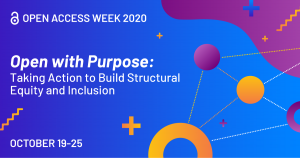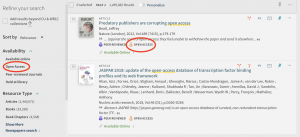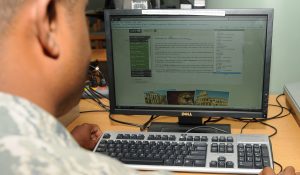Every two years, the ACRL Research Planning and Review Committee publishes in College & Research Libraries News an article on the top trends and issues affecting academic libraries and the change our institutions are experiencing. We will be highlighting some of these trends through a number of blog posts over the next few weeks.

Welcome to Open Access Week 2020! As with many fields, research institutions and the Open Access community are reexamining how existing practices and systems are built upon historical practices of discrimination and exclusion. This year’s International Open Access Week theme is Open with Purpose: Taking Action to Build Structural Equity and Inclusion. Check out the International Open Access Week site or follow the Twitter hashtag #OAWeek to learn more and join the conversation.
Open Access (OA) refers to “free, immediate, online access to the results of scholarly research, and the right to use and re-use those results” as needed (SPARC). The underlying principle behind Open Access is that making research and scholarly work open will benefit humanity as a whole by making knowledge available to all, and allowing other researchers to review and build upon work done by their peers. Advancement happens when “research results are made openly available to the community so that they can be submitted to the test and scrutiny of other researchers…new research builds on established results from previous research” (cOAlition S). We’ll consider some of the current trends in OA that affect academic libraries.
The push toward Open Access has gained momentum in the past fifteen years as the relationships between research institutions and publishers has changed. Since the 1990’s, publishers have sold journal subscriptions as bundles to institutions (usually through their libraries), similar to a cable package. The publishers have benefitted by guaranteeing these revenue streams, and institutions have benefitted by being able to provide access to a higher volume of scholarly writing than they would if they were working with individual journals. Over time, however, the cost of these packages (referred to as “big deals”) has risen faster than most academic library budgets, and there is sometimes little flexibility in choosing the content available through these deals.
Additionally, a great deal of the research done worldwide is publicly funded, so researchers generally create scholarly content and review the work of their peers at no cost to the publishers. Publishers charge institutions to publish research findings, and then again to access that scholarly content that their own researchers created. Scholarly publishing has become very profitable for publishers, even as the cost of subscription fees has grown increasingly prohibitive for institutions.
Libraries at many institutions have reassessed the value of these deals and whether or not the large expenditure for bundled journal access is worth it. There have been several high-profile examples of breaks between institutions and publishers in the past couple of years, including the University of California and Massachusetts Institute of Technology ending their contracts with Elsevier, and more. The Scholarly Publishing and Academic Resources Coalition (SPARC) tracks the status of big deals cancelled by selected research institutions and consortia worldwide here.
With many of these traditional agreements ending, institutions and publishers are finding new ways to work together. These kinds of contracts are called “transformative agreements,” which generally means contracts move away from the traditional subscription-based model and toward Open Access publishing. The term “transformative” is somewhat open to interpretation, and there are different definitions. In general, however, transformative agreements typically involve the following components: changes in cost structures (a “shift from paying subscriptions to paying for publishing”), copyright held by authors/creators rather than publishers, and making contract terms available to the public.

One positive trend is the growing number of resources available to institutions and organizations looking to learn more about Open Access, and possibly rethink their contracts with publishers. These include the University of California Office of Scholarly Communications’ toolkit for negotiating with publishers, which was developed based upon UC’s experiences in negotiating with Elsevier. The Efficiency and Standards for Article Changes (ESAC) Initiative, which aggregates information for the open access market and publishers, maintains a registry of transformative agreements worldwide as a resource for institutions looking to change their own contracts with publishers. ESAC also maintains a collection of negotiating principles from institutions and consortia worldwide for reference.
An organization of European scientific agencies, called cOAlition S, formed in 2018 and launched an initiative to require that scientific research supported by public funds must be published in alignment with Open Access principles by 2020. Last year, this deadline was moved to 2021 in order to give researchers and publishers more time to adapt their practices. The fundamental principles of Plan S have not changed, and the plan includes guidance on how to implement this shift. The scientific community will no doubt be monitoring this plan and how it affects participants, but we may see a considerable shift in this direction.
Developers have created several tools to support users access the growing number of Open Access resources. These include Open Access Button, Unpaywall, Lazy Scholar, and Kopernio, all of which function as browser extensions to help researchers find Open Access versions of scholarly articles. There have been several recent studies that assess the usability and effectiveness of these tools, including these two published in Information Technology & Libraries that evaluate the user experience and effectiveness of such tools. As these tools are refined, and more are developed, we can expect to see additional studies on their usability and how they impact research.

When using SearchBox to explore the University Libraries collections, members of the CU community can find OA resources in their search results by simply selecting the “Open Access” filter in the left navigation column.
Additional Reading:
- Read about past years’ Open Access Week trends and resources on Catholic University Libraries What’s Up posts.
- Berlin Declaration on Open Access. 2003. https://openaccess.mpg.de/Berlin-Declaration
- Sjoberg, Cindy. 2017. “E-Journals and the Big Deal: A Review of the Literature.” SLIS Student Research Journal, 6(2), January.
- Society Publishers Coalition (SocPC) and the Transitioning Society Journals to Open Access (TSPOA). 2019. “Webinars Charting Paths Forward for Open Access Publishing by Learned Societies.” December. Three-part webinar series: https://tspoa.org/resources/webinars/.
- “Editorial: UC open access fight exposes publishing rip-off.” The Mercury News, March 6, 2019.



